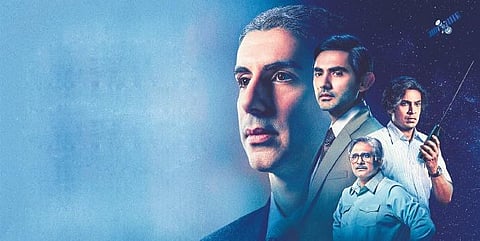

Explaining why characters in his movies abstain from household chores or even take a bath if they are not getting killed, Alfred Hitchcock said that audiences do not come to the theatres to watch their prosaic scenes at home being depicted on screen; it damages the magic. Movies are meant to entertain and be an ephemeral escape from reality.
But heroes are not just made by action and dancing and singing. Sometimes they can be astronauts and scientists, taking their nation through the uncharted territories of science. Indian movies have tried to capture or build plots around scientific achievements. Some of them clung to the audience-approved parameters and structures. But OTT platforms have taken a different orbit.
The Rocket Boys has near-perfect casting and delves into, with profound research, the lives and the relationships shared by the two pillars of our nation’s scientific progress – Homi J Bhabha and Dr Vikram Sarabhai. As a nation grapples with food scarcity, poverty, and illiteracy, they dream of giving the people a scientific course of life.
Adjudged a flop and almost interminable, Swades brought into the mainstream the great canyon that exists between science and the rural population. Based on the lives of Aravinda Pillalamarri and Ravi Kuchimanchi, who returned to their motherland to develop a pedal power generator, the film punches the audience with raw realism of the grassroots and that rockets and rovers do not always reflect a nation’s surge of science.
Released on Independence Day four years ago, Mission Mangal deals with the launch of India’s first interplanetary expedition, the Mars Orbiter Mission by Isro, but filled with the extravaganza of a “masala movie”. However, it was a deliberate effort to reach out to a larger audience whose space ken is paltry, and have no wish to invest in a physics lecture at least in the theatres. With the film garnering around Rs 290 crore, Mangalyaan was accomplished in an estimated Rs 450 crore, making it the most economical Mars mission, which the plot hammers on.
With adventure in every shot, Parmanu: The Story of Pokhran, showed the other side of the political triumph of the nuclear tests in 1998 - how the Indian Army outwitted the CIA. With a cursory look into diplomacy and global ramifications, the film transmits the tension that men at the cusp of history have to handle and a significant chapter when India claimed her place in an elite club was put on celluloid.
Jawaharlal Nehru wanted to instill a scientific temper in the nation.
When Satyajit Ray made Ganashatru: Enemy of the People, based on Henrik Ibsen’s play, he was pilloried for attacking religious belief because a doctor tries to warn people about bacteria in the holy waters of a temple in the movie. What Ray wanted to convey was the mammoth influence of faith that dwarfs rationale, and the plot was emblematic of various primitive practices prevalent in society.
There is of course no movie on the scale of Oppenheimer and Interstellar but comparisons overshadow the impact of such films and others to bring science into mainstream productions, starring top actors and directed by bigwigs. It is laudable that some of the country’s milestones are now etched in cinematic history, opening up opportunities for pure science plots in the future.